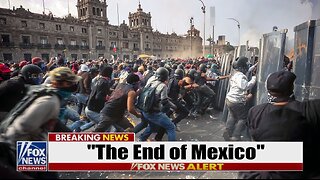Premium Only Content

Episode 3154: The Seeds of Revolution: Pope Paul VI and the Prelude to Bergoglio
Nightly Zoom Coordinates for Rosary:
Meeting ID: 865 8978 0399
Passcode: Wjjv4960!
Speak Lord for your Servant is Listening
Book Recommendation of the Day
“Victories of the Martyrs” by St. Alphonsus Liguori
• Includes narratives of early Christian martyrs, including St. Vincent of Saragossa.
• Written by a Doctor of the Church, this work combines biography with spiritual reflection.
The Seeds of Revolution: Pope Paul VI and the Prelude to Bergoglio”
I want to take you deep into the mid-20th century, into the very heart of the post-Conciliar revolution. A time that Our Lady of Good Success
Quito, Ecuador – 1594–1634
Our Lady gave explicit prophecies about the 20th century, especially its middle years, warning of a great crisis in the Church:
"In the 19th century and particularly in the 20th, Satan will reign almost completely by means of the Masonic sects... The Sacrament of Matrimony, symbolizing the union of Christ with His Church, will be attacked and deeply profaned... The secular clergy will leave much to be desired because priests will become careless in their sacred duties..."
"The devil will try to persecute the ministers of the Lord in every possible way... He will corrupt many of them and will scandalize the Christian people..."
"This will mark the arrival of the times of the final chastisement."
Our Lady specifically mentioned that these warnings and messages were intended to be known in the 20th century, especially by those living in a time of crisis in the Church.
Our Lady of La Salette (1846, France)
Our Lady warned:
"Rome will lose the faith and become the seat of the Antichrist... The Church will be in eclipse..."
Our Lady of Fatima (1917, Portugal)
Sister Lucia (the Fatima seer) told Cardinal Oddi and others that the crisis concerned a great apostasy beginning at the top of the Church.
Venerable Fulton J. Sheen (1950s)
Not a Marian apparition, but a prophetic Catholic voice, Sheen stated:
"We are living in the days of the Apocalypse — the last days of our era... The Church is undergoing a trial... We are beginning now to witness the spread of the apostasy..."
He spoke often of a “counter-church,” which sounds eerily similar to concerns voiced by Our Lady in certain apparitions.
So myself going through 4 Popes (Paul VI, JPII, Benedict and Francis) I saw Pope Francis (Jorge Mario Bergoglio) as a radical departure from tradition, but the real groundwork was laid long before him particularly by Pope Paul VI, the pontiff who closed the Second Vatican Council and enacted its reforms.
Paul VI was the “pre-Bergoglio,” in this episode, we explore why.
Segment 1: Montini Before the Tiara – Hidden Modernism
Giovanni Battista Montini was born in 1897 in Northern Italy. Early in his priesthood, he entered the Vatican diplomatic corps and served under Pope Pius XII. But even during this conservative pontificate, Montini’s tendencies toward modernism and liberal humanism became evident.
• He supported the controversial worker-priest movement in France, which blurred the lines between sacred and secular vocations.
• He had close associations with Jacques Maritain, a Thomist philosopher whose attempts to reconcile democracy and Catholicism paved the way for liberal Catholic thought.
• In 1954, Montini was appointed Archbishop of Milan, a prestigious role, but he was notably not made a cardinal by Pius XII a break from custom. Many believe this was due to Pius XII’s concerns over Montini’s theological direction.
Montini was part of a new generation of clerics who sought to “update” the Church not just in method but in doctrine and mission.
He absorbed the influence of Teilhard de Chardin, Henri de Lubac, and other Nouvelle Théologie thinkers all of whom had been censured under previous pontificates.
Montini was modernism in a cassock, waiting to be enthroned.
Segment 2: The Second Vatican Council : A Pandora’s Box Opened
Pope John XXIII convened Vatican II in 1962, but he died in 1963. Montini was elected as Pope Paul VI and inherited the Council. What followed was not organic development, but revolution disguised as reform.
Paul VI guided the Council to its conclusion in 1965 and rapidly implemented its decrees:
• Lumen Gentium introduced a confusing notion of the Church’s structure, undermining the monarchy of the papacy with “collegiality.”
• Nostra Aetate opened the Church to interreligious relativism.
• Gaudium et Spes adopted a tone of cooperation with the modern world, rather than a prophetic critique of it.
Paul VI intentionally suppressed dissent from traditional theologians, while promoting progressives. The periti (theological experts) he favored such as Karl Rahner, Hans Küng, and Yves Congar openly advocated ideas previously condemned by the Magisterium.
This Council broke with the tradition of anathemas and clarity and instead issued ambiguous “pastoral” documents paving the way for rupture.
As Archbishop Marcel Lefebvre would later declare:
“We have gone from a God-centered Church to a man-centered Church.”
Segment 3: The Novus Ordo Missae: A Liturgy Fabricated
Of all the changes under Paul VI, none was more catastrophic than the replacement of the Traditional Latin Mass with the Novus Ordo Missae in 1969.
The new Mass was:
• Constructed by a committee led by Archbishop Annibale Bugnini, later exposed for his Masonic affiliations and exiled to Iran.
• Influenced by six Protestant observers, who ensured the Mass could be more acceptable to their theology, removing explicit references to the Holy Sacrifice, sin, and the Real Presence.
• Drastically changed in language and structure: Latin was suppressed in favor of vernacular tongues. The altars were turned around. Sacred music was replaced with banal, folk-inspired songs.
Cardinal Ottaviani, former head of the Holy Office, said in his famous intervention:
“The Novus Ordo represents… a striking departure from the Catholic theology of the Mass as defined at the Council of Trent.”
The Mass is the source and summit of the Faith and Paul VI allowed it to be dismantled.
Segment 4: Doctrinal Confusion and the Illusion of Unity
Even in his attempts to uphold doctrine such as in Humanae Vitae (1968), which reaffirmed the Church’s teaching against artificial contraception Paul VI allowed widespread rebellion to go unpunished.
• Bishops’ conferences in Canada and Europe openly rejected the encyclical.
• Catholic universities and theologians signed manifestos of dissent.
• Seminaries stopped teaching moral absolutes.
Paul VI did not discipline these violations. Instead, he praised pluralism and “dialogue.”
Simultaneously, Paul VI:
• Gave away the papal tiara as a gesture of humility.
• Opened the Church to the World Council of Churches.
• Signed a joint declaration with the Orthodox that lifted the mutual excommunications of 1054, without requiring the Orthodox to return to the Church.
The Papacy, once seen as the bulwark of truth, became an agent of compromise.
Segment 5: The Pre-Bergoglio: Continuity in the Revolution
Pope Francis is often described as a break from tradition but only if one ignores the foundation built by Paul VI.
• Francis’ preference for ambiguous language (“who am I to judge?”, “God wills the diversity of religions”) is the pastoral ambiguity of Vatican II perfected.
• His liturgical minimalism and disregard for tradition flow directly from the desacralized ethos of Paul VI’s reforms.
• His ecumenical gestures from Pachamama to Abu Dhabi are just the next step in Paul VI’s abandonment of the missionary mandate.
Paul VI was the “pre-Bergoglio” not merely because of chronology, but because of ideological continuity.
The difference between Paul VI and Francis is not substance, but speed and style.
Conclusion: Reclaiming What Was Lost
Traditional Catholics must recognize that the rot did not begin with Francis. It began with the acceptance of modernism at the highest levels of the Church.
Paul VI is a warning: compromise with error, even for peace, leads to apostasy.
Yet we are not abandoned. God has preserved the Faith through the Traditional Latin Mass, the clear doctrine of the saints, and the fidelity of small but faithful communities.
Like Gideon’s army, we may be few but we are chosen.
"Unyielding Faith: The Crown of St. Vincent of Saragossa"
Epistle – 2 Corinthians 6:4–10
“But in all things let us exhibit ourselves as the ministers of God: in much patience, in tribulations, in necessities… as sorrowful, yet always rejoicing; as needy, yet enriching many; as having nothing, and possessing all things.”
Reflection on the Epistle
St. Paul, the great Apostle of endurance, gives us a description of authentic Christian witness: patient suffering, hidden joy, detachment from material things, and a rich inner life united to Christ.
This could easily describe St. Vincent, the noble deacon of Saragossa, who suffered terribly under the Diocletian persecution. He was tortured with iron hooks, placed on hot coals, and confined in prison, yet never gave in to compromise or despair. His soul echoed today’s reading: having nothing, and yet possessing all things because he possessed Christ.
Let us reflect: Do we embrace tribulation with joy for the sake of Christ? Do we see suffering as a means to glorify God? In the example of St. Vincent, we find courage to stand firm in truth, even when truth is mocked or denied.
Gospel – Luke 10:16–20
“He that heareth you, heareth Me… Behold, I have given you power to tread upon serpents… but rejoice not in this, that spirits are subject to you; but rejoice in this, that your names are written in heaven.”
Reflection on the Gospel
Our Lord's words cut through the noise of worldly achievement: the true joy is not in miracles or gifts, but in being known by God, our names inscribed in the Book of Life.
St. Vincent, as a deacon, proclaimed the Word of God with power and authority. But when Rome commanded him to burn the sacred Scriptures and renounce Christ, he refused, choosing instead to endure martyrdom. Why? Because he cared not for earthly reward or power, but only to be found faithful.
Christ’s Church is not measured by popularity or prestige, but by fidelity. Rejoice not in what you do, but in who you are in Christ. Let this Gospel be a reminder that spiritual power must always be rooted in humble obedience.
Saint of the Day – St. Vincent of Saragossa
Born in Huesca, Spain, and ordained a deacon by Bishop Valerius of Saragossa, St. Vincent suffered horrific torments under the Diocletian persecution around A.D. 304. Refusing to surrender the Scriptures or recant the Faith, he bore unimaginable pain with serenity and even joy.
His captors were astounded how could a man so broken in body remain so whole in spirit? The answer: Christ dwelt in him. His relics were venerated throughout Spain and beyond, and he became one of the Church’s most beloved early martyrs.
Today, when the Church suffers new wounds sometimes inflicted from within may St. Vincent’s resolve become our own. May his prayers obtain for us holy courage.
Quotes & Themes for Meditation
• “As sorrowful, yet always rejoicing.” – 2 Cor. 6:10
→ Christian joy is born in fidelity, not comfort.
• “Your names are written in heaven.” – Luke 10:20
→ The only glory worth striving for is eternal life with Christ.
• St. Vincent’s Example:
→ True courage is remaining faithful when everything else is lost.
Conclusionary Prayer
Let us pray:
O God, who didst grant strength and steadfastness to Thy holy martyr St. Vincent of Saragossa, deacon of the Church, that he might endure torture and death rather than betray the truth, grant us, we beseech Thee, a share in that same courage.
Strengthen us in trials, keep us faithful in persecution, and may our names be found written in Heaven. Let us seek not the approval of the world, but the embrace of the Crucified.
Through the intercession of St. Vincent and Our Lady, Queen of Martyrs, may we always stand firm in the faith of the apostles.
Through Christ our Lord. Amen.
St. Vincent of Saragossa, pray for us.
Our Lady of Sorrows, intercede for us.
Sacred Heart of Jesus, have mercy on us.
In the Name of the Father, and of the Son, and of the Holy Ghost. Amen.
Let us never forget: the truth is worth dying for and living for. Until next time, remain faithful, pray fervently, and stand firm.
Deo gratias!
-
 LIVE
LIVE
TimcastIRL
2 hours agoDemocrats COLLUDED With Epstein To HURT Trump, Emails BACKFIRE
21,909 watching -
 LIVE
LIVE
Dr Disrespect
11 hours ago🔴LIVE - DR DISRESPECT - ARC RAIDERS - STELLA MONTIS QUESTS
1,355 watching -
 LIVE
LIVE
SpartakusLIVE
4 hours agoSolos on WZ to Start then ARC?! || Friends: UNBANNED
452 watching -
 12:58
12:58
Cash Jordan
4 hours agoMexican MOB OVERTHROWS Capital... as "Socialist President" FLOODS AMERICA with CARTELS
1801 -
 23:13
23:13
Jasmin Laine
6 hours agoPBO Breaks His Silence—“This Is Soviet Stuff”… and the Panel EXPLODES
7926 -
 UPCOMING
UPCOMING
Jamie Kennedy
18 hours agoCatching Up With Deep Roy: JKX Stories, Star Wars Secrets, and Total Chaos | Ep 231 HTBITY
180 -
 LIVE
LIVE
ThisIsDeLaCruz
49 minutes agoThe Secrets Behind Madonna’s Legendary Live Sound
63 watching -
 1:22:15
1:22:15
Glenn Greenwald
5 hours agoTrump and JD Vance Weigh in on the MAGA Civil War Over Tucker; Zelensky's Top Associates Embroiled in $100 Million Corruption Scandal; FBI's Ongoing Concealment About Trump Shooter | SYSTEM UPDATE #548
94.3K78 -
 LIVE
LIVE
megimu32
1 hour agoON THE SUBJECT: 2000s Pop Punk & Emo Nostalgia — Why It Still Hits
120 watching -
 LIVE
LIVE
VapinGamers
1 hour agoBattlefield RedSec - Getting Carried Maybe? I Need the Wins! - !rumbot !music
122 watching